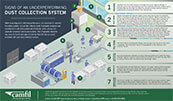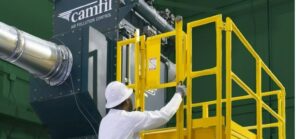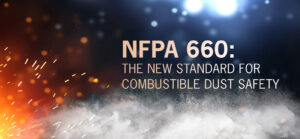Industrial dust collection systems are designed to prevent harmful and bothersome dust and fumes from settling on surfaces. They are commonly used in manufacturing and processing operations, both indoor and outdoor dust collectors, to ensure compliance with major regulatory bodies such as OSHA, NFPA, and EPA, and to protect workers.
It's important to distinguish dust collectors from other systems like industrial vacuum systems and housekeeping dust systems. While those systems are ideal for precision cleaning and material conveyance, dust collectors are designed for full-scale facility or process filtration.
There are several different types of dust collector systems available that cater to varying facility sizes, types of process dust, and applications. While there's no "superior" type of dust collector, some may perform better than others depending on the specific application.
Some popular styles of industrial dust collection systems include:
- Cartridge dust collectors
- Baghouses
- Wet scrubbers
- Portable dust collectors
Cartridge Dust Collectors
Cartridge-style dust collectors are popular for general-purpose factory air cleaning systems, as they work well in many different applications. These collectors use filter cartridges filled with pleated nonwoven fabric, known as media, to capture dust and fumes from the airstream as it moves through. The filter media provides a large surface area on which to capture dust.
The filter media is made from a blend of polyester and cellulose and is sometimes coated with nanofibers in order to better release the dust when the cartridges are pulse cleaned. Media can also be made of spunbond fabric for increased durability against fibrous dusts or for duststhat require high-efficiency filtration

How They Work
Cartridge-style collectors work by constantly drawing in large volumes of air to filter out impurities generated during production processes. The dust-laden air enters the collector through a baffled inlet and passes through the filters where the dust is trapped in the filter media.
The filtered air is then either recirculated back inside or vented out of the facility. However, as the dust accumulates on the filter media over time, it creates resistance that blocks the airstream. To resolve this issue and relieve the pressure, the system uses a pulse-cleaning method that involves a blast of compressed air through the center of the filter to eject the dust into the hopper.
Some filters may release more dust than others, but filters that use proprietary HemiPleat® pleating technology are superior as they stay cleaner and last longer. The technology uses synthetic beads to keep the pleats evenly spaced, resulting in more surface area for filtering. This enables more dust to be loaded onto each cartridge before it needs pulse cleaning, and the dust is more easily released during pulse cleaning, which helps to normalize the differential pressure..
HemiPleat technology uses synthetic beads to hold open the pleats and keep them evenly spaced, creating more surface area available for filtering inside each filter cartridge. This means more dust can be loaded onto each cartridge before it requires pulse cleaning. It also means the dust releases more readily when it is pulse cleaned, returning the differential pressure to normal. Click here to watch a 1-minute video demonstrating HemiPleat technology.
Ideal Applications for Cartridge Dust Collectors
Cartridge dust collectors are ideal for these applications:
- Welding, laser or plasma cutting
- Grain, seed and feed processing
- Woodworking
- Food manufacturing and processing
- Chemical processing
- Paper and metal packaging materials manufacturing
- Solid dose pharmaceutical product manufacturing
Baghouses
Baghouses operate similarly to cartridge dust collectors, but are capable of handling higher volumes of dust-laden air. Baghouses (also called bag filter or fabric filter) operate in a similar way to cartridge dust collectors.
Like cartridge-style collectors, baghouses function as dust particle collectors, removing particles from the air using a fan that forces the air through long cylinder-shaped bags made from woven fabric. They also use a pulse-cleaning system to reverse-blast dust through deformation of the filter bags.
How They Work
In a baghouse dust collection system, dust-laden air enters through the bottom of the dust collector then is filtered through the bags. The dust accumulates on the outside surface of the bags. At regular intervals, a burst of compressed air is shot through a parabolic nozzle that creates a shockwave, causing the particles to fall into the hopper. The filtered air is either recirculated or expelled outside, depending on the application and regulatory requirements.
Ideal Applications for Baghouses
Baghouses work best for applications involving:
- High CFM (airflow)
- Harsh environments like mining
- Applications that produce high volumes of dust
- High-temperature applications
- Sticky or abrasive materials
- Dust contaminated with oil and moisture
Wet Scrubbers
Wet scrubbers, which are also called air scrubbers, utilize water or another liquid to remove dust particles from the air. They're a popular choice for operations involving potentially explosive or flammable materials or where the slurry consisting of liquid and collected dust particles can be reused.
How They Work
Wet scrubbers move liquid through a vortex zone within the unit, creating turbulence that atomizes the liquid into fine droplets. These droplets mix with the particle-laden air stream, and are then removed by centrifugal force.
Maintaining a clean or recycled water supply is important with wet scrubbers. The concentration of dust particles in the scrubbing fluid must be kept below 5% in order to maintain operating efficiency. If the dust is combustible, the amount allowed to accumulate in the discharge vats is regulated by NFPA.
Wet scrubbers can effectively remove fibers and fluff including sticky dusts by filtering air and dust through rough filtration before skimming it over the surface of the water or scrubbing liquid. A compact multi-application-use wet scrubber like the Camfil Vortex is ideal for this purpose.
For more demanding applications with higher dust loading, Camfil’s Venturi is a more effective choice. It injects water, via a pump, into the inlet of the unit. Extremely high velocities are generated which create contact surfaces with the scrubbing liquid. The result is an effective mixing of the scrubbing liquid and the contaminated air stream. The particle-laden droplets are separated from the airstream by centrifugal force.
Ideal Applications for Wet Scrubbers
Wet scrubbers work best for applications involving:
- Wet or sticky dusts
- Humid air
- Combustible dust
Portable Dust Collectors
Portable dust collectors, also known as unit dust collectors, are small and designed for isolated jobs that produce dust. These jobs may or may not be located near your larger dust collection system.
Portable dust collectors can be strategically positioned to capture dust from the source. They can be used on their own or in conjunction with a larger dust collection system to help extract any fugitive dust from the air.
How They Work
Portable dust collectors like Camfil’s Zephyr function similarly to larger cartridge dust collectors, but on a smaller scale. The unit contains a long collection arm and hood that can be positioned to collect dust and fumes at the source.
Dust-laden air travels through the arm and passes through a cartridge filter. When the filter becomes overloaded, a shot of compressed air can be directed through the filter to release the dust into the tray to be removed.
However, it's crucial to note that portable dust collectors are not suitable for explosive dusts and solvent fumes.
Ideal Applications for Portable Dust Collectors
Portable dust collectors work best for applications including:
- Isolated jobs not located near an inlet for your larger dust collection system
- Small shops that do not need a larger dust collection system
- Heavy dust load applications to work in tandem with a larger dust collection system
There are many available options to meet your dust, fume and mist collection needs. If you need help selecting the right option for your operations, our experts are here to help.





